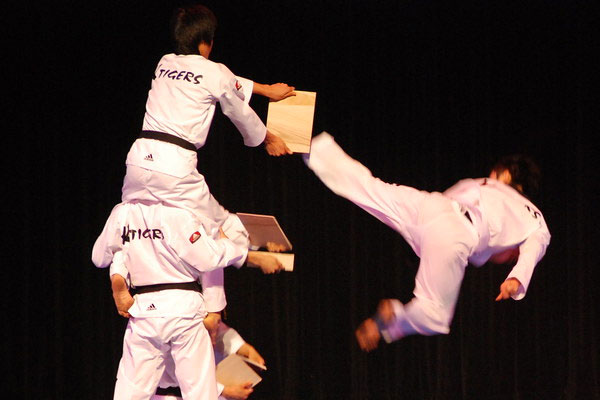Martial Arts Near Me
Taekwondo
Taekwondo, a traditional Korean martial art recognized for its high-flying kicks, rapid movements, and incredible athleticism, has become a popular global sport. This ancient martial art has a rich and fascinating history, prominently featuring its origins in Korea, the development of its techniques, and its current status as an Olympic sport. In this article, we will delve into the history of Taekwondo, explore its techniques, and examine its current status as a worldwide martial art.
The history of Taekwondo can be traced back thousands of years to ancient Korea. Korea is renowned for its martial arts heritage, and various forms of combat techniques were practiced throughout the peninsula. The earliest roots of Taekwondo can be found in these ancient Korean combat styles. However, it was during the Three Kingdoms period (57 BC – 668 AD) that specific martial arts systems began to develop.
During the Goguryeo Dynasty (37 BC - 668 AD), a martial art named "Subak" was widely practiced. Subak, the forerunner to Taekwondo, focused on striking and kicking techniques. It became highly popular during the time of the Joseon Dynasty (1392-1897 AD) under the name "Taekyon". Taekyon was practiced not only as a self-defense method but also as a form of entertainment during festivals and celebrations.

In the early 20th century, Korea faced Japanese occupation, resulting in the suppression of Korean cultural practices. The occupation prompted a revival of Korean martial arts, aiming to restore national identity and pride. Numerous martial artists, known as "dojangs," united to form various styles, laying the foundations for modern-day Taekwondo.
The development of Taekwondo techniques can be primarily attributed to two military training organizations in Korea during the mid-20th century: the Korea Taekwondo Association (KTA) and the ROK Army Taekwondo group. The KTA was established in 1955 and aimed to consolidate and categorize various martial arts styles into a single unified system.
One of the key figures in the modernization of Taekwondo was General Choi Hong Hi, who played a vital role in founding the KTA. General Choi formulated a unique martial art consisting of a vast array of high kicks, lengthy jumping and spinning kicks, hand strikes, and blocks. This new system was officially named Taekwondo in 1955, which translates to "way of kicking and punching."
As Taekwondo transformed into a national sport, it continued to evolve by integrating techniques from other martial arts such as karate and Chinese martial arts. The emphasis on explosive, high-impact kicks and speed set Taekwondo apart from other martial arts, resulting in its recognition as a distinct discipline.
The international recognition of Taekwondo as a sport began in the 1960s and 1970s when it gained widespread popularity in Europe and North America. In 1973, the World Taekwondo Federation (WTF) was established, aiming to govern and standardize the sport's rules and regulations worldwide.
The efforts to make Taekwondo an Olympic sport reached fruition in 1988 when it was included as a demonstration sport in the Seoul Summer Olympics. Taekwondo's astounding success led to its official inclusion in the Summer Olympics program starting from the 2000 Sydney Olympics. Since then, Taekwondo has captivated worldwide audiences with its electrifying kicks, fierce competition, and stunning athleticism.
Taekwondo gained further recognition at the global level through its acceptance into other multi-sport competitions such as the Asian Games, Pan American Games, and European Games. These platforms have allowed practitioners from all over the world to showcase their skills, elevating the status of Taekwondo as a true global martial art.
Today, Taekwondo is widely practiced in more than 200 countries, with millions of practitioners ranging from children to adults. Its popularity as a martial art stems from the values it imparts, including discipline, respect, perseverance, and self-control. Taekwondo also offers various benefits to its practitioners, such as physical fitness, improved mental focus, stress relief, and self-defense skills.
The techniques and forms of Taekwondo have evolved over the years to cater to a wide range of practitioners. It is now practiced as a traditional martial art, a modern sport, and a form of self-defense. The culmination of these aspects, along with its inclusion in prestigious events like the Olympics, has significantly contributed to Taekwondo's growth and global appeal.
In recent years, there has been a greater emphasis on enhancing the judging system to provide fairer outcomes in competitions. The introduction of electronic scoring equipment has helped improve the accuracy and transparency of scoring in Taekwondo matches.
Furthermore, organizations like the International Taekwondo Federation have introduced adaptive programs, making Taekwondo accessible to individuals with disabilities, emphasizing the inclusive nature of this martial art.
With a history rooted in ancient Korean martial arts, Taekwondo has evolved into a dynamic and globally recognized martial art and sport. Its techniques, combining speed, agility, and high-impact kicks, have captivated practitioners and audiences alike. Taekwondo's inclusion in the Olympics and other prestigious competitions has elevated its status as a world-class martial art, promoting discipline, respect, and physical well-being. As Taekwondo continues to evolve, it remains an influential force in promoting Korean culture and values, inspiring countless individuals worldwide to embark on a journey of self-discovery through martial arts.